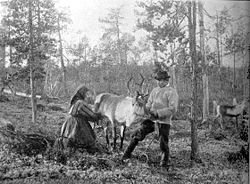Animal husbandry: Difference between revisions
Pollinator (talk | contribs) rem linkspam |
|||
| Line 50: | Line 50: | ||
==External links== |
==External links== |
||
* [http://www.milkacademy.com Milking equipment and dairy farming resources] Useful contents about milking equipments, dairy farming |
|||
* [http://www.pv.wageningen-ur.nl/english/ Research Institute for Animal Husbandry] |
* [http://www.pv.wageningen-ur.nl/english/ Research Institute for Animal Husbandry] |
||
* [http://www.fao.org Food and Agriculture Organization of the United Nations (FAO)] |
* [http://www.fao.org Food and Agriculture Organization of the United Nations (FAO)] |
||
Revision as of 23:34, 13 July 2007
This article needs to be updated. |

Animal science is the agricultural practice of breeding and raising livestock.
The science of animal husbandry, called animal science, is taught in many universities and colleges around the world. Students of animal science may pursue degrees in veterinary medicine following graduation, or go on to pursue master's degrees or doctorates in disciplines such as nutrition, genetics and breeding, or reproductive physiology. Graduates of these programs may be found working in the veterinary and human pharmaceutical industries, the livestock and pet supply and feed industries, or in academia.
Historically, certain sub-professions within the field of animal husbandry are specifically named according to the animals that are cared for.
Different types of animal husbandry



A swineherd is a person who cares for hogs and pigs (older English term: swine). A shepherd is a person who cares for sheep. A goatherd cares for goats. A cowherd cares for cattle. In previous years, it was common to have herds which were made up of sheep and goats. In this case, the person tending them was called a shepherd. Camels are also cared for in herds. In Tibet yaks are herded. In Latin America, llamas and alpacas are herded.
In more modern times, the cowboys or vaqueros of North and South America ride horses and participate in cattle drives to watch over cows and bulls raised primarily for food. In Australia many herds are managed by farmers on motorbikes and in helicopters. Today, herd managers often oversee thousands of animals and many staff. Farms and ranches may employ breeders, herd health specialists, feeders, and milkers to help care for the animals. Techniques such as artificial insemination and embryo transfer are frequently used, not only as methods to guarantee that females are bred, but to help improve herd genetics. This may be done by transplanting embryos from stud-quality females, into flock-quality surrogate mothers - freeing up the stud-quality mother to be reimpregnated. This practice vastly increases the number of offspring which may be produced by a small selection of stud-quality parent animals. This in turn improves the ability of the animals to convert feed to meat, milk, or fiber more efficiently and improve the quality of the final product.
Ethical aspects of animal husbandry

There are contrasting views on the ethical aspects of breeding animals in captivity, with one debate being in relation to the merits of allowing animals to live in natural conditions reasonably close to those of their wild ancestors, compared to the view that considers natural pressures and stresses upon wild animals from disease, predation, and the like as vindication for captive breeding.
Some techniques of animal husbandry such as factory farming, tail docking, the Geier Hitch and castration, have been attacked by animal welfare groups such as Compassion In World Farming. Some of these practices also are criticized by farmers who use more traditional or organic practices. Genetic engineering is also controversial though it does not necessarily involve suffering. Animal rights groups are vocal in their criticism of systems of animal agriculture.
Some domesticated species of animals, such as the vechur cow, are rare breeds and are endangered. They are the subject of conservation efforts.
See also

- Aquaculture
- Beekeeping
- Breeder
- Cuniculture
- Dog breeding
- Factory farming
- Feed conversion rate
- Horse breeding
- Poultry
- Pastoral nomads
- Sheep husbandry
- Shepherding
- Transhumance
- food industry
- Animal keeping
- Ex-situ conservation
- Wildlife conservation
